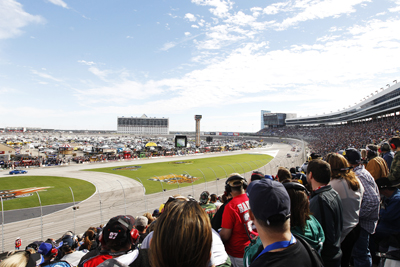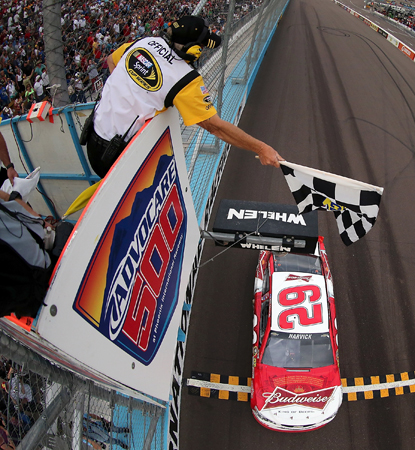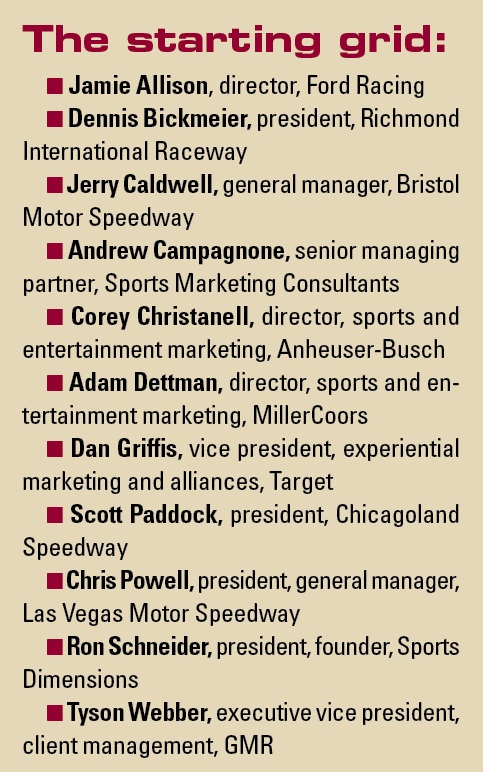We asked NASCAR stakeholders to give their take on how the sport could grow. From track presidents to sponsors, they realize the importance of attracting a younger and more diverse crowd. But they also acknowledge the need to protect the core fan base that built NASCAR into what it is today. Here are highlights of their responses, which were submitted by email.
■ Where should NASCAR focus its attention to grow its fan base, from the track to the
television?
COREY CHRISTANELL, ANHEUSER-BUSCH: I think NASCAR should focus on its core consumer. While they are getting older, they need to maintain the core while using new media to bring younger consumers in. I think they should capitalize on the sport’s regional strength and make new consumer entries within those geographies.
DAN GRIFFIS, TARGET: Every decision NASCAR makes should help to answer one of two questions: 1) How does it make it easier for primary sponsors and manufacturers to do business in the sport and 2) How does this grow our fan base at a rate faster than anything else a sponsor can spend their money on.
ANDREW CAMPAGNONE, SPORTS MARKETING CONSULTANTS: NASCAR needs to reach the younger demographic in schools and engagement around the STEM Education Coalition, which would expose the younger demo to the importance of automobiles to our country and also the importance of engineering and math. This would help expose them to the sport at a young age, so they would follow the sport. I also believe NASCAR should engage much deeper into the gaming space as kids and young adults have great interest in interactive gaming and real-life experiences using sports, and of course social media.
RON SCHNEIDER, SPORTS DIMENSIONS: Think young. Think diverse. NASCAR must be relevant in these two areas moving forward. For sponsors, the youth and growing Hispanic demographics will be their next customer base for growth. Focus on what is appealing to the younger market … digital/mobile accessibility (including Wi-Fi “net” at the tracks, relevant entertainment, such as “hip” bands) and partner with brands that are already connected with youth such as Red Bull, Apple, etc. Develop an emotional tie to the drivers that everyday young people can relate to. Regarding diversity, more emphasis on the similar attributes NASCAR has with Hispanics, for example family oriented, spiritual/faith, loyal, etc.
CHRIS POWELL, LAS VEGAS MOTOR SPEEDWAY: Maybe the biggest issue facing our sport ... is the need to appeal to younger fans while we continue to covet the fans who helped the sport grow in the ’80s, ’90s and early 2000s. Putting a great product on the speedway is still paramount, but we also need to develop younger racers and race fans and engage sponsors who play to a more youthful demographic, thus enhancing the live-event experience for the younger crowd. While our industry has done a good job of using social media as a means to communicate with prospective fans, we now are turning our attention to making improvements in the at-track experience through data communications and connectivity. Basically, we’re striving to keep NASCAR’s “cool” factor.
 |
The panelists said NASCAR must prevent the erosion of its existing fan base as it works to build avidity among the youth demographic.
Photo by: Getty Images |
JAMIE ALLISON, FORD RACING: Whenever I think of growth, I always think that the holy grail of all sports is to be relevant to the next generation. Today’s youth generation is growing up in an era of social media. With the advent of Facebook, Twitter, Snapchat and others, those are the mediums and platforms that we live by today. I think the changes to the Chase format, as well as to the qualifying, drives the right interests in a generation that wants something that is high energy, something that is a little disruptive, something that’s exciting. It’s a good intersection. It’s all intended to resonate with a generation that is more used to bite-size experiences.
JERRY CALDWELL, BRISTOL MOTOR SPEEDWAY: Some of the moves NASCAR has made as a sanctioning body in the past couple of years, from “boys have at it” to the recent changes to the Chase and qualifying procedures, are steps in the right direction. Fans want personality, they want intense competition and they want competitors who have a passion for what they do. We work hard at Bristol to create the entire experience, start to finish of the weekend, not just start to finish of the race. But the cause, effect and result of those races still drive the fans’ passion. Television is a critical partner in everything we do in exposing the masses to our sport. But to get the true, full, in-your-face experience, that comes at the track.
TYSON WEBBER, GMR: Engaging fans and consumers through content, technology and media will allow for a larger distribution at a time and place that is convenient for the consumer and can assist in growing the distribution and avidity of the sport. NASCAR reassuming its rights from Turner will allow for greater control of the product, but relevancy, creativity and quality will need to remain high to keep fans and potential fans engaged.
DENNIS BICKMEIER, RICHMOND INTERNATIONAL RACEWAY: The entire industry is focused on this, and the NASCAR Industry Action Plan outlines many key pillars to get there, so I think alignment and commitment to initiatives to support that plan is ultimately what will help grow the base. More specifically for us, some of our key initiatives are focused on fan access and providing opportunities to better connect fans with the stars of the sport, youth-oriented programs and providing quality all-day entertainment.
ADAM DETTMAN, MILLERCOORS: It won’t be one area of focus that drives fan interest and growth. Collective efforts across the sport with measured changes such as the modifications to the Chase format and qualifying demonstrate that NASCAR is prepared to embrace the future.
One interesting dichotomy — broadcast rights/television ratings versus track revenue/ticket sales. There may be a day in the not too distant future, especially for tracks that have two NASCAR Sprint Cup races during the season, where we could see a move to prime time TV in an effort to create ritualistic viewing occasions to infuse growth in NASCAR nation. Perhaps the 2012 Daytona 500 run on Monday night gave us a preview.
SCOTT PADDOCK, CHICAGOLAND SPEEDWAY: The sanctioning body, track operators and broadcast partners must collectively continue to invest in technology to deliver the most compelling race-day and broadcast experience possible to the fans. This past offseason, Chicagoland Speedway and other ISC facilities made substantial investments to upgrade the fiber optic infrastructure at our venues to ensure that fans receive the type of “connectivity” they are seeking while attending the live event experience.
A focus on the overall race weekend “experience.” While our avid fans make the race weekend commitment clearly to enjoy the exciting on-track racing product, we must deliver a compelling overall weekend experience for the casual and first-time fan in an effort to entice them to return to the venue. This event programming includes live musical entertainment, camping, tailgating, sponsor activation, kids activities, and providing unique access.
■ What are specific pockets of growth for NASCAR to build upon its base?
GRIFFIS: Today’s youth are not as enamored with owning a car and driving a car as they were 20 years ago. Some kids these days don’t get their driver’s license until they are 20 or 21. To love racing starts with the love of the automobile. Grow the love of the automobile with young fans and you will grow a new fan base.
SCHNEIDER: Make things easier on the fans. From better connections to their phones to lower ticket prices at the tracks, NASCAR has to work with tracks to produce a connected experience during races. Leverage the loyalty of the current fan by rewarding them or providing “friends and family” incentives. … Consider more awareness and visibility of NASCAR’s heritage … appeal to the good old days and throwback era.
Keep it simple … don’t overcomplicate the sport. Understand that NASCAR needs to change the formats to keep interest, like the Chase format. However, too much tinkering will confuse the fans and actually turn them off. It’s a fine balance, but to the current fan base, the tradition, driver personalities and competition is what brought them to the sport in the first place.
I would also say from a sponsor/corporate standpoint, the tracks are still overpriced on their activation opportunities such as display space and hospitality. … Many companies, including our clients, have backed off of entertaining at the track, and especially the suites. We are looking for creative ways to make the experience affordable, but it is definitely a challenge. It would be great to see discounts and incentives for larger corporate groups to participate on race weekends.
CAMPAGNONE: Hispanic demographic and establishing a car culture again with the younger demographic.
CHRISTANELL: I think they are doing some of the right things (i.e. Chase changes) to keep fans engaged
 |
NASCAR received high marks for changes to the Chase format that emphasize winning.
Photo by: Getty Images |
throughout the season. However, all consumer bases today are overwhelmed with data and are interested in more things since so much data is available to them. The onus is on the sponsors and drivers to portray themselves authentically within the sport to engage a fan base long term.
ALLISON: We at Ford have really re-aimed all of our outreach to the digital front. Because when you go to a digital format, it’s not just for younger consumers, it’s now mainstream. We reached over 1 million followers on Facebook just for Ford Racing. By using such tools, which NASCAR is doing and we are doing, it invigorates the opportunity for fans to follow the sport, both through social media and physically.
CALDWELL: Appealing to young fans now, building a great experience with their families, creates memories they want to pass along to their kids when they reach that point. However, we cannot take our eye off the ball of the loyal, longtime fans who helped us get where we are. You cannot have growth if at first, we do not prevent erosion.
WEBBER: There are a few pockets of growth that NASCAR could build on including multicultural and a more global audience, but a very important one is the younger audience and keeping the next generation of NASCAR fans engaged and interested in the sport. NASCAR has made good strides with several of its initiatives recently and a continued focus on elevating the drivers to superstar status will continue to help this cause. Elevating the drivers would help with a broad audience, but will have specific appeal to a younger audience.
Another interesting angle for NASCAR to build on its youth base could be to try and reignite the love affair with cars. Many of the changes NASCAR has made to the car has made it more stock in its look to make the connection back to the manufacturer and cars on the road. A focus from NASCAR and the manufacturing partners to rekindle the love affair with cars, parents working on it with their kids, could reignite a love for racing and NASCAR with a younger generation.
BICKMEIER: You have to look at initiatives to engage all three levels of fans: avid, casual and first time. Our avid fans can help us build the base by connecting them with casual fans at the track or other non-race day activities. If we can create experiences for avid and casual fans to interact, we can leverage their passion to elevate casual fans, and it isn’t just face-to-face experiences; social media is helping in this regard. We have to look at opportunities to introduce first timers to the sport by creating a thrilling and memorable experience at the track, providing excellent customer service, and building programs aimed at attracting families, youth and multicultural guests.
DETTMAN: Millennials represent a core growth opportunity for NASCAR. It’s the next generation of NASCAR nation. But for millennials, especially those in urban markets, where owning a car isn’t a priority, building relevancy for the sport can be challenging. NASCAR has made a concerted effort to bring “influencers” out to the track and leveraged the experience and accessibility for all the best the sport has to offer. Social media, fantasy sports, content creation — all efforts which build on the strength of a long season to create robust fan engagement platforms.
PADDOCK: We have the opportunity to grow our younger fan base from youth to 18-34, while also capturing the interest of multicultural audiences. These are key tenets of the NASCAR Industry Action Plan and significant resources, both personnel and otherwise, have been invested toward working these critically important initiatives. … If we collectively stay committed to the plan, we will see the benefits in time.






